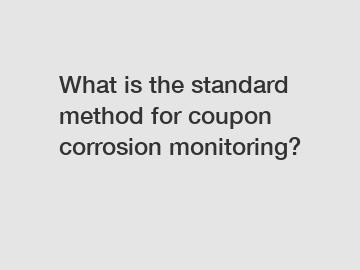What is the standard method for coupon corrosion monitoring?
With competitive price and timely delivery, Huade Hydraulic sincerely hope to be your supplier and partner.
Coupon corrosion monitoring is a widely used method for assessing the corrosion rate and integrity of metallic structures in various industries. The standard method for coupon corrosion monitoring involves the use of metallic coupons that are exposed to the same corrosive environment as the structure being monitored. By placing the metallic coupons in the same environment, the corrosion rate and severity can be accurately measured and analyzed.
The basis for the standard method of coupon corrosion monitoring lies in the principle of corrosion potential measurement and the understanding of electrochemical reactions. When a metallic coupon is exposed to a corrosive environment, it undergoes an electrochemical reaction known as corrosion. This reaction involves the transfer of electrons from the metal surface to the corrosive medium, leading to the formation of metal ions and the deterioration of the coupon.

To monitor the corrosion rate of a metallic structure, the first step is to select a suitable coupon material that is compatible with the corrosive environment. The coupon material should have similar chemical composition and physical properties as the structure being monitored to ensure accurate measurement. Commonly used coupon materials include carbon steel, stainless steel, and aluminum.
Once the coupon material is selected, it is prepared by cleaning, weighing, and measuring its surface area. The coupon is then exposed to the corrosive environment for a specific period of time, which can range from weeks to months depending on the expected corrosion rate. After the exposure period, the coupon is retrieved, cleaned, and re-weighed to calculate the weight loss due to corrosion. The corrosion rate can be determined by dividing the weight loss by the exposure time and the surface area of the coupon.
The standard method of coupon corrosion monitoring provides valuable information on the corrosion rate, uniformity, and damage mechanisms of metallic structures. This information is crucial for maintaining the structural integrity and safety of various industries, including oil and gas, chemical, and maritime industries. By monitoring the corrosion rate, operators can assess the effectiveness of corrosion prevention measures, optimize maintenance schedules, and make informed decisions regarding repairs or replacements.
Moreover, the data obtained from coupon corrosion monitoring can be used to evaluate the performance of corrosion inhibitors, protective coatings, and cathodic protection systems. It enables engineers and researchers to assess the effectiveness of corrosion mitigation strategies and develop more efficient and cost-effective corrosion control measures.
In conclusion, the standard method for coupon corrosion monitoring involves the use of metallic coupons exposed to the same corrosive environment as the structure being monitored. The method is based on the principle of electrochemical reactions and provides accurate measurement of corrosion rate and severity. This information is essential for maintaining the structural integrity and safety of various industries, optimizing maintenance schedules, and evaluating the effectiveness of corrosion control measures.
For more information, please visit our website.
Want more information on rotary directional valve wholesale? Feel free to contact us.



